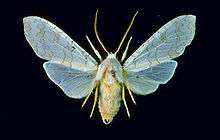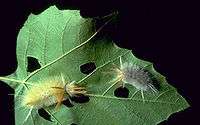Halysidota harrisii
Halysidota harrisii, the sycamore tussock moth, is a species of moth of the family Erebidae and the tribe Arctiini, the tiger moths. The species was first described by Benjamin Dann Walsh in 1864.[1] It is found in southeastern Canada, the eastern parts of the United States (but not Florida) and northeastern Mexico. The wingspan is about 50 mm. The moth flies from May to June and from July to August depending on the location.[2]
| Halysidota harrisii | |
|---|---|
 | |
| Scientific classification | |
| Kingdom: | Animalia |
| Phylum: | Arthropoda |
| Class: | Insecta |
| Order: | Lepidoptera |
| Superfamily: | Noctuoidea |
| Family: | Erebidae |
| Subfamily: | Arctiinae |
| Genus: | Halysidota |
| Species: | H. harrisii |
| Binomial name | |
| Halysidota harrisii Walsh, 1864 | |
The larvae feed on the American sycamore tree (Platanus occidentalis). An overpopulation of the insect can be damaging to sycamore trees. The ideal way to manage the moth and caterpillar populations is to foster a healthy bird population.
The sycamore tussock moth caterpillar has been documented causing urticaria (hives).[2]

.jpg)
References
- Savela, Markku. "Halysidota harrisii (Walsh, 1864)". Lepidoptera and Some Other Life Forms. Retrieved September 17, 2019.
- Smith-Norowitz, TA; Norowitz, KB; Kohlhoff, S; Kalra, K; Chice, S; Bluth, MH (2010). "Immune response profiles after caterpillar exposure: a case report". Journal of Inflammation Research. 3: 45–51. PMC 3218733. PMID 22096356.